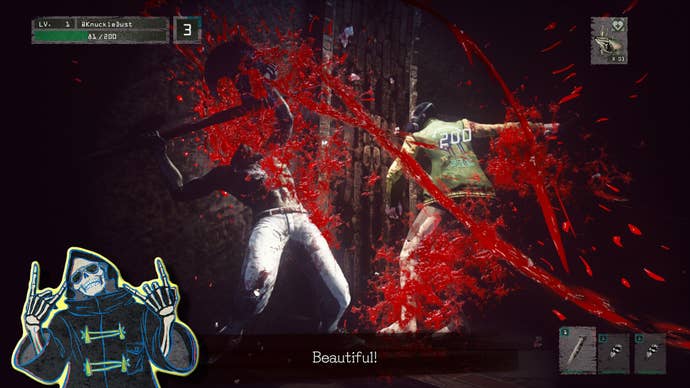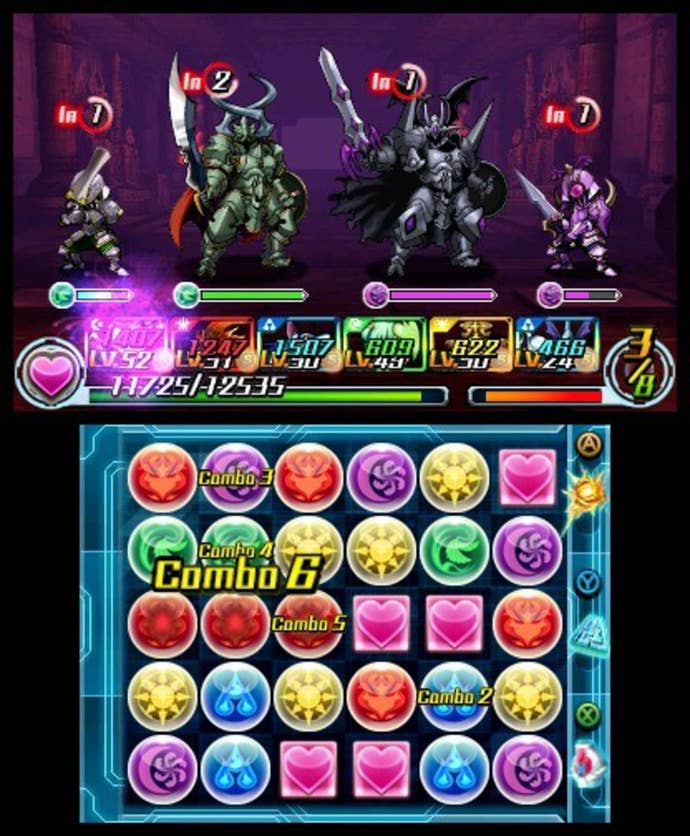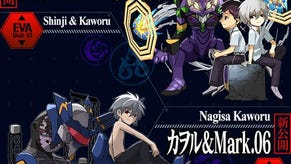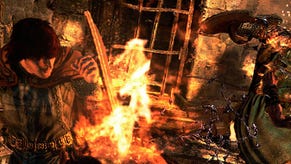Let It Die is 'Supremely S**tty,' And GungHo's CEO Couldn't Be Happier
We sit down to talk to the creator of Puzzle & Dragons about Let it Die's success and its potential as a springboard to a more global profile for GungHo Online.
This article first appeared on USgamer, a partner publication of VG247. Some content, such as this article, has been migrated to VG247 for posterity after USgamer's closure - but it has not been edited or further vetted by the VG247 team.
All travel expenses for this story were paid for by GungHo Online Entertainment. The interpreter for the interview was GungHo America producer Tyler Inouye.
You won't hear many CEOs laugh when someone calls one of their games "supremely shitty," but Kazuki Morishita is not most CEOs.
The head of GungHo Online—creators of the extremely popular Puzzle & Dragons series—was on hand for Japan's GungHo Festival, the finale to a nine-stop national tour of Japan for fans of GungHo's games. Part concert series, part gaming tournament, part talk show, the festival drew thousands to Makuhari Messe, the site of the annual Tokyo Game Show.
The crowds were there not to play games but to enjoy live music (all from artists with songs featured in Let It Die) and hear the latest announcements. Even Let It Die, which is not a free download in Japan due to its CERO-Z "adult only" age rating, was not playable anywhere at GungHo Festival. Instead, staffers were handing out free PSN codes to anyone they deemed eighteen or older.
With little in the way of games to play at GungHo Festival, it was on stage where fans could see games in action—or hear players air their grievances to Morishita's face. The latter took place during a Let It Die panel chat where Morishita and director Hideyuki Shin sat down with experienced players and heard what they had to say. One such player was Hideki Osada, former Famitsu editor-in-chief, who called Let It Die a "supremely shitty game" which Morishita and Shin both found hilarious.
I later sat down with them at GungHo headquarters in Tokyo and asked them how they felt about their big-budget free-to-play experiment being called a "shitty game" in front of thousands of people. Did they feel like their free-to-play Dark Souls-like brawler was a "shitty game," and was that deliberate?
"Oh, it was totally on purpose. All the calculations went towards making it a shitty game," Morishita said with a chuckle. He explained how there are two different kinds of shitty games: "One is just so shitty that you can't do anything about it, it's just s**t. There's another kind of game where people play and get frustrated and call it a shitty game."
Noting that everyone on stage at GungHo Festival had played Let It Die for many hours, Morishita said "they still continue to play because the frustration fuels their want to play."
"A lot of games recently, especially on smartphones, people just play mindlessly. You can enjoy yourself but it doesn't bring out any emotion," Morishita said. "What we were going for was to really pull that emotion out of players and get them involved deep into the game. We want to bring out emotions in our players to the point where they scream 'F**k!' 'Goddamnit!'" Morishita pretended to smash a controller as he yelled.
"Hearing players say 'it's a piece of s**t, f**k this' is really an honor. That's exactly what we were going for. It's dissing the game with love."
Both on stage and throughout our interview, Morishita seemed content to laugh at himself and his work, though he believes in it. "When we announced Let It Die at E3 a few years ago and said it would be free-to-play," he said, "[the press] told us 'you're probably not going to do very well.' We thought that's what they would say. And because they told us that, we wanted to show them what's up. So we're glad that everyone was against us."
Morishita talked about GungHo games with a personal tone because, from his point of view, the company's games start with him. "From the very first steps of development as far as design is concerned, I create [each game]," he said. "I then see what staff is available or not too busy with other projects to come in, making it a group of two or three people including myself, to then brush up the idea I came up with to see if we can make it even better. This is a very 'top-down' style of game making we have here at GungHo."
Morishita believes that this is how Akihiro Hino runs Level-5, but admitted this is an unusual approach in the world of Japanese game development.
Even for games that are already out, Morishita said he remains involved in the creation of related media connected to GungHo games. "Puzzle & Dragons Cross has a TV animation that's aimed at 12-year-olds. I am a very important part of the development of the scenarios in that show. But then when I have to switch over to Let It Die, I have to switch to a completely opposite version of myself."
"The stress that builds up from creating the scenarios for the Puzzle and Dragons anime was released in making Let It Die," Morishita said, laughing, of his multiple roles. He would repeat the sentiment that he found working on Let It Die cathartic several times during our interview.
Morishita was a keynote speaker at the Tokyo Game Show back in 2013 when he said that games on consoles and mobile devices should complement each other. I asked him if, four years later, he still felt that was the case.
"I still believe that is true but as the years have gone by they pretty much are on different paths," he said, "because the way you play console games and the way you play mobile games is completely different."
"Console games are like breakfast, lunch, and dinner," he continued. "Smartphone games are snacks, like potato chips: you eat some, put it down, pick it up later and eat some more. But for dinner, you sit there and have a nice meal. Mobile games are more for killing time."
Given that analogy, I asked if he was worried that players might eat so many potato chips they might not have room for a Let It Die meal. Morishita said that, due to their different demographics, he does not believe the audiences for GungHo mobile games and Let It Die overlap.

Let It Die as a Stepping Stone to the Future
Morishita heralded Let It Die as a harbinger of GungHo games to come. "Up until now we've been making our titles at a Japanese audience," he said, describing the approach as "Japan First" in english. "But starting with Let It Die and from now on, we're going to be more global-oriented. Global First."
"From now on we'd like to look at a worldwide initiative to release our titles at the same time," he said. "Not release in Japan and then in North America and Europe, if anything we'd like to release in the Western markets first and maybe Japan after, like we did with Let It Die."
"The titles that we're working on right now in-house are definitely 'Global First.' In regards to these new titles that we're working on, the game setting, the world setting, the character design, all the art is less for a Japanese audience and more for a global audience."
As part of his "global first" approach, I asked if he thinks there could be a GungHo Festival outside Japan. Morishita replied, "It would great to bring people in and have a World Championship outside Japan, maybe in Dodger Stadium," while noting the company has already held championship tournaments for titles in Thailand, Taiwan, and the Philippines. "In that sense, we've kind of been on the eSports trend a lot earlier," he said.
With Let It Die being the first of Gungho's "global first" push, I asked about the challenge of drawing new users to a free-to-play game, especially a violent one. Morishita seemed unconcerned with appealing to "new" players. "If you're not a 'gamer' you don't need to play this game. It's not for you," he said. "To those users, I invite them to play Puzzle & Dragons."
"We decided from an early stage of development that of course, free-to-play is more for casual users but let's make a core game free-to-play," said producer Shuji Ishikawa. "If a casual user comes in and becomes a core user, that's great. But [Let It Die] was never meant to be for all users."
If attracting new players was unimportant, I wondered about retaining lapsed players. I offered myself as an example: I downloaded Let It Die at launch in December, played it once, and never went back to it. I asked what the team would say to someone like me.
"Don't come back," Morishita said, making everyone laugh. "But if you do want to, please try it again. It's always great if we have more users playing our game."
"Connectivity is better, a lot of the bugs have been squashed," said Ishikawa in defense of the improvements the game has undergone. "We've added a beautiful sorting option to inventories and a lot of other things have been adjusted so it's easier to play and get a bit further in the game now. It's not that we broke it, we just made a lot of improvements."
Regarding improvements to Let It Die, the team made it clear that they took customer feedback seriously—to a point. For example, the fact that players have been allowing high-level characters to die on lower levels, thus becoming powerful AI opponents called Haters who are notoriously hard to kill for newbies. Morishita said that if this practice upsets the notion of high-risk-high-return (because killing these Haters nets little reward), they will see if adjustments can be made.
"When players give us any comments and complaints," Morishita said, "if we hear them and say 'yeah that makes sense' then that's something we prioritize to see if we can adjust. If there's something that is, from a game design standpoint, 'just how it is' then that's something we probably will not fix. We will not make any adjustments to the game that goes against the main core design."
"For example," said Shin, "when you go up an escalator after you clear an area and go back down it, the enemies respawn. Some players said 'please make the enemies not respawn because it's too hard' and I said 'Nope.'" Everyone laughed. "That goes against the game."

Something that does not go against the game is corporate collaboration. At Gungho Festival, a Let It Die x Gravity Rush crossover was announced but not elaborated upon. Morishita said they are actively seeking more companies to partner with for special team-ups like this one. "If anyone has an IP they want to put in Let It Die, let us know!" he said.
As more and more Japanese publishers who achieved fame during the console era devote their resources to mobile apps, it's refreshing to see a company that hit it big on mobile go the other direction by embracing consoles. GungHo games may not appeal to everyone but every GungHo game seems to be made for someone, even if that someone is just the CEO.
"My philosophy [of making games] is not have a philosophy, because if you have a philosophy you tend to stick with it," Morishita said about his approach to game development. "I'm always looking for new things and new challenges. There are a lot of titles in mid-development [at GungHo] that never saw the light of day."
Whether Grasshopper Manufacture's Let It Die becomes the keystone of that push or a stepping stone along the way remains to be seen. At the very least, the team's enthusiasm for the project's future got me to download the game again as soon as I returned home— despite Morishita's warning that I should not.








